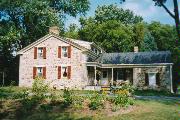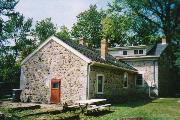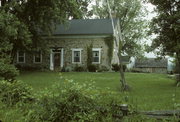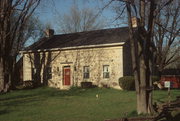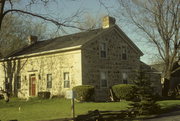Property Record
12510 N WAUWATOSA RD
Architecture and History Inventory
| Historic Name: | O'Brien-Peuschel Farmstead - House |
|---|---|
| Other Name: | |
| Contributing: | Yes |
| Reference Number: | 13512 |
| Location (Address): | 12510 N WAUWATOSA RD |
|---|---|
| County: | Ozaukee |
| City: | Mequon |
| Township/Village: | |
| Unincorporated Community: | |
| Town: | |
| Range: | |
| Direction: | |
| Section: | |
| Quarter Section: | |
| Quarter/Quarter Section: |
| Year Built: | 1846 |
|---|---|
| Additions: | 1870 |
| Survey Date: | 1985 |
| Historic Use: | house |
| Architectural Style: | Greek Revival |
| Structural System: | |
| Wall Material: | Fieldstone |
| Architect: | |
| Other Buildings On Site: | |
| Demolished?: | No |
| Demolished Date: |
| National/State Register Listing Name: | O'Brien-Peuschel Farmstead |
|---|---|
| National Register Listing Date: | 10/24/2000 |
| State Register Listing Date: | 4/14/2000 |
| National Register Multiple Property Name: |
| Additional Information: | Two 'site files' titled (John Peuschel House & O'Brien-Peuschel Farmstead) exists for this property. They contain additional information such as correspondence, newspaper clippings, or historical information. They are public records and may be viewed in person at the Wisconsin Historical Society, Division of Historic Preservation. RETURNED EAVES, DOOR W/SIDELIGHTS AND TRANSOM. RAISED MORTAR JOINTS. HABS WI-155. DETERMINED 12/28/1994. Wisconsin’s first German settlement began in 1839 in the township of Mequon, when Heinrich von Rohr and a group of Old Lutherans established the community of “Freye Stätte” (Freistadt) and formed the state’s first Lutheran congregation. These religious conservatives had fled Pomerania because they objected to Prussian King Frederick William III’s decision to merge the Lutheran Church with the Prussian Reformed Church. That same year, Adolph Zimmerman and William Opitz settled nearby and opened the Mequon Brewery. Soon a wave of German immigrants swept into Ozaukee County. Among these Lutheran settlers were John Peuschel, a native of Saxony, and his Prussian-born wife Henriette. In 1855, the couple established this farm on 80 acres, which they later expanded to 120 acres. Along with the land, the Peuschels acquired a stone house, built in 1844, and a wooden hay barn and wooden granary, both constructed around 1850. The house is a fine example of fieldstone construction with a mortar matrix. Several features evoke the formality of the Greek Revival style, especially the dressed stone quoins, tying the corners of the walls together; the side-gabled roof with prominent cornice returns; the broad frieze below the eaves; and the prominent entry, framed by sidelights and a transom. In 1870, the Peuschels added a one-story fieldstone wing to the rear. Four years later they built a fieldstone barn behind the residence. The well house, outhouse, concrete silo, and corncrib were constructed sometime around 1900. |
|---|---|
| Bibliographic References: | ZIMMERMANN, RUSSELL "THE HERITAGE GUIDEBOOK" (HERITAGE BANKS 1976). INSCRIPTION. PERRIN. Mequon-Thiensville Courant 7/30/1998. Mequon-Thiensville Courant 3/8/2001. Buildings of Wisconsin manuscript. |
| Wisconsin Architecture and History Inventory, State Historic Preservation Office, Wisconsin Historical Society, Madison, Wisconsin |

